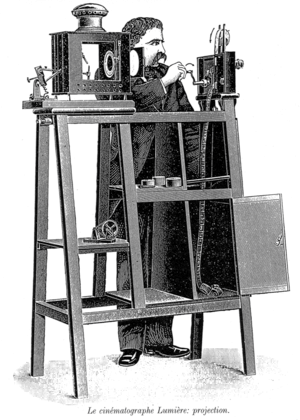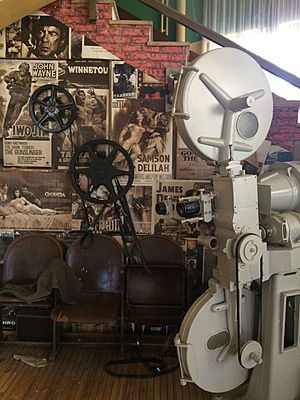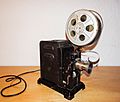Movie projector facts for kids
A movie projector is a cool machine that shows moving pictures. It works by shining light through film and projecting the images onto a big screen. Think of it like a super powerful flashlight that can show a whole movie! Many parts inside a projector are similar to those found in a movie camera.
History of Movie Projectors
The very first movie projector was called the Zoopraxiscope. A British photographer named Eadweard Muybridge invented it in 1879. This machine showed pictures from spinning glass disks really fast. This made the pictures look like they were moving!
At first, the pictures were painted onto the glass disks. They looked like dark shapes. Later, Muybridge made new disks from 1892 to 1894. These had drawings printed on them using photography, and then they were colored by hand.
A Polish inventor named Kazimierz Prószyński (born 1875, died 1945) also helped with early cinema. He created his own film camera called the Pleograph. He patented it even before the famous Lumière brothers. He also made movie projectors better for a company called Gaumont. He even invented a popular hand-held camera called the Aeroscope.
Another important step came from Frenchman Louis Le Prince. He was working in Leeds, England. In 1888, Le Prince got a patent for a special device. It had 16 lenses and could work as both a movie camera and a projector.
In 1888, he used an updated version of his camera. He filmed the very first motion picture ever, called Roundhay Garden Scene. These early moving pictures were shown privately in a place called Hunslet.
The Lumière brothers invented the first really successful movie projector. They made their first film in 1894. It was called Sortie de l'usine Lumière de Lyon.
This film was shown to the public a year later in La Ciotat, France. The first public showing of movie films happened in Paris on December 28, 1895. Their invention, the cinematograph, was also shown at the Paris Exhibition in 1900. There, films by the Lumière Brothers were projected onto a huge screen. It was about 16 by 21 meters (or 52.5 by 69 feet) big!
Images for kids
-
Imaging lens Diastar of an Askania 35 mm movie projector (focal length: 400 mm)
-
A photo of a 35 mm film print featuring all four audio formats (or "quad track")- from left to right: SDDS (blue area to the left of the sprocket holes), Dolby Digital (grey area between the sprocket holes labelled with the Dolby "Double-D" logo in the middle), analog optical sound (the two white lines to the right of the sprocket holes), and the Datasat time code (the dashed line to the far right.)
See also
 In Spanish: Proyector cinematográfico para niños
In Spanish: Proyector cinematográfico para niños














